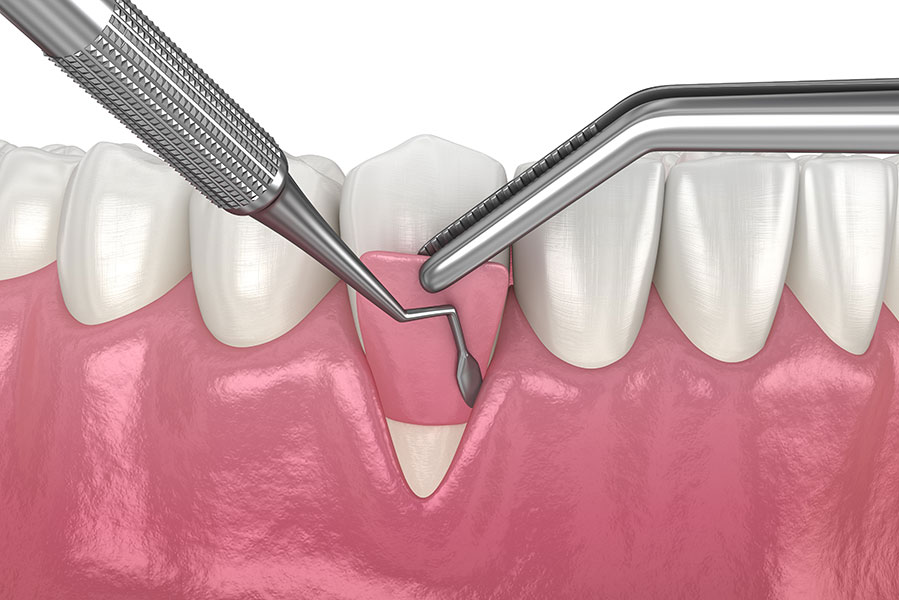At the facilities of Dr. Suzanne Caudry, we have restored the gums of several patients and understand the most common causes of gum recession. While some of these causes might be obvious to you, others might actually surprise you.
Continue reading to learn more about gum recession, its causes, and more. If any questions come to mind, don't hesitate to contact us at (416) 928-3444. We are always ready to take a call.
What Is Gum Recession?
Before we delve into the common causes of gum recession, we should first take a moment to review the problem of gum recession itself.
For those who only have a vague idea of gum recession, the term refers to the gradual loss of gum tissue in a patient's mouth. Some people might experience gum tissue loss later in life, while other's gums might gradually recede over time. Gum recession can happen to anyone, even those who maintain excellent dental care.
What Does Gum Recession Look Like?
Many people live with gum recession without even knowing that their gums have receded. Many patients of ours simply dismiss their recessed gums as a byproduct of their naturally “toothy” smile.
While it is true that receding gums can make someone look as though they have larger-than-normal teeth, the teeth themselves are rarely the issue. The problem stems from the receding gum line. If left untreated, the recession can increase making the teeth appear even larger as time goes on.
Not Just a Cosmetic Problem
While gum recession might make people feel self-conscious about their smile, receding gums can lead to more than just cosmetic troubles. Gums act as a protective barrier for your teeth, helping the teeth's roots steer clear of the bacteria that can cause a variety of dental issues.
As gums recede, teeth and their roots become more and more exposed to bacteria.
Your Gums Protect Your Teeth
While the crown (top) of your tooth is protected by enamel, the root is not. Not only will these roots and the underside of gums become more vulnerable, but the roots will also be more exposed to hot and cold foods. This sensitivity to hot and cold foods might make for an uncomfortable eating and drinking experience.
Causes of Gum Recession
Gum Recession: Is It Genetic?
There are many people who believe that gum recession is a genetic trait. While some may have lived with gem recession for longer than they can remember, this is not exactly the case.
Contrary to popular belief, an individual does not inherit recessed gums from their family. That said, roughly 30% of the population are genetically susceptible to gum disease, which can itself lead to a recession of the gums.
Gum Disease
Gum disease, also known as periodontal disease, is a common cause of gum recession. Untreated gum disease has the potential to infect the soft tissue that comprises the gums by way of infection and inflammation.
Excessive Brushing
Lots of people live their lives thinking that they should brush their teeth as aggressively as possible. This is not the case. Aggressive brushing can actually contribute to the recession of the gums. By brushing too hard against the gums, the toothbrush inadvertently pushes the gums away from the crown. Over time, these aggressive practices will expose more and more of the root.
Improper Flossing
Everyone knows that flossing is an important part of any oral care regimen-but not everyone knows how to floss properly. When flossing between your teeth, be mindful not to pull the floss one direction or the other when the floss is close to the gum line. Doing so only pulls the gums in an aggressive manner.
Poorly Fitted Dentures
Professionals go to great lengths to ensure that partial or complete dentures fit their patients, but mistakes happen sometimes. Those who have ill-fitting dentures may notice gum recession surrounding the dentures themselves. If your dentures don't feel right, it may be a sign that they do not fit your mouth properly. Be sure to schedule a follow-up appointment with your dentist to have them adjusted as soon as possible.
Cigarettes and Tobacco Products
The inhalation of tobacco products leads to the accumulation of tartar and bacteria on the teeth and gums. If left unchecked, the tartar will eventually eat away at the gums that cover the roots of the teeth, leaving them exposed and susceptible to several dental problems.
How to Fight Gum Recession
Gum recession can be halted by practicing proper hygiene-but it takes more than proper brushing and flossing to reverse the effects of gum recession. When you are looking to restore your smile to its former glory, the cosmetic dentists at Dr. Caudry's facility are here to help you. Here, we perform soft tissue grafts for gums on a regular basis-and with unparalleled success.
How Long Does a Gum Graft Take?
Depending on the extent of the surgery, patients can expect to be out of the dentist's chair in as little time as two to three hours. Healing can take several weeks. Afterward, you will once again have healthy-looking gums that suit your smile perfectly.
Learn More About Gum Recession Now
Do you have more questions about gum recession treatment and other aspects of our periodontal practice? If so, we invite you to contact us. Email us, leave a comment, or call our offices at your convenience!

